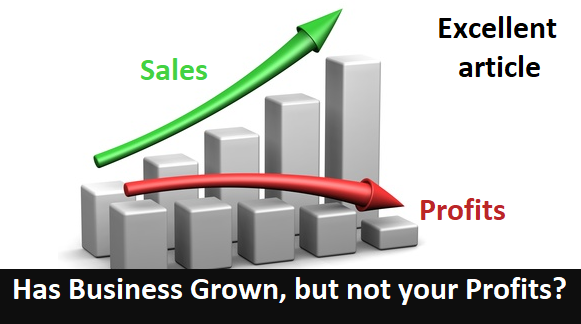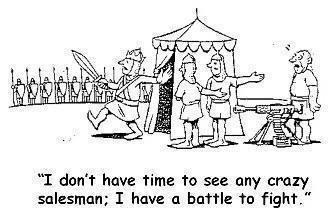Business Has Grown, Profits Haven’t
If your business has grown, but the company’s profits haven’t improved – along with the growth – it isn’t all that unusual. This scenario happens to small and medium-sized companies a lot more often than most people think.
Managing growth is a challenging process, particularly when it’s your first time reaching a new level. Sometimes the profits completely evaporate. Even larger companies can experience losses.
This can be one of the most stressful times in your life. Particularly if you are working harder than ever. You might even start wondering if you have what it takes to be a business-person.
If this describes you then I’ve got some news for you. Successful business-people don’t have some specially gifted ability or even a private supply of magic pixie dust.
What they do have is experience and access to resources that came from learning ‘on the job’ just like you’re doing now.
If you could talk to yourself in the future you likely wouldn’t change this experience for anything. I know some very accomplished business-people who have experienced some very challenging times feel this way. Business acumen is developed through active learning.
This might not seem all that comforting right now, in fact, I doubt much will until your company is profitable again. I know this because I’ve been there.
Back to the challenge at hand. Your business growth shows there’s demand for the products and services. Even better – you’re actually finding customers who are willing to pay for them. That’s a clear indication that your company is aimed at a viable business opportunity.
Focus is the key. Interestingly if you bought a camera you’d want it to be able to pan out and see the big picture and then you’d also want it to be able to focus back in and get a clearly detailed picture of the areas that can be improved. That’s the type of focus you’ll need for this challenge as well. Here’s a good wide-angle look – that might surprise you.
“People don’t own businesses
What they actually own are companies that do business with markets”
Long term success comes from building a company that profitably delivers value to your target markets. That’s the challenge in a nutshell. Rock Solid Coaching & Consulting helps people tackle that challenge.
Companies rarely build themselves, but many owners somehow seem to expect that to happen naturally. All too often owners put all their energy into doing business. Early on in the company’s development, this can be a good strategy, but and it’s a big BUT, as the business grows
more attention needs to be directed towards
designing and building the company
Strong companies don’t need owners to be involved in the day-to-day processing of the business. In fact, the more time you have to stand back and study how your company profitably processes business the better off your company’s development will be.
At Rock Solid we call this M-Time
The M stands for Meta. The definition of Meta means about the thing itself. It’s seeing from a higher perspective instead of from inside the thing, it’s about being self-aware.
Metacognition means thinking about one’s thinking. Typical patterns of thinking for example.
Metadata means examining how the data was collected and processed.
Metaphysics is the branch of philosophy that examines the fundamental nature of reality, including the relationship between mind and matter, between substance and attribute, and between potentiality and actuality.
M-Time is when you work on designing and building your company. This is when long-term success is born, but there are challenges.
It’s all too easy to get caught up in the excitement of running the business. If you don’t make enough E-Time then sooner or later it will catch up to you – and then it becomes a grind.
Most entrepreneurs need an experienced guide to help them use their M-Time effectively. It’s one thing to know the business like the back of your hand, but it’s another set of skills and abilities that builds a strong profitable company.
At Rock Solid this is our specialty.
It doesn’t happen overnight, but think of the company as the engine – long term success in business comes from building a powerful and efficient engine. Otherwise, you’ll be ‘knee-deep’ processing your business for most of your time ‘owning’ the business.
Baseball is a good metaphor for designing a profitable company. To score batters have to get all the way around the bases and across home plate. If you only get to third, you don’t score and you can’t win the game if you don’t score. Where do you need to improve to get your profits to grow?
- Batters’ Box – Sales and Marketing
- First Base – Direct Costs: the cost of delivering the product/service
- Second Base – Overheads: the company’s operating expenses. Facility, admin and financial expenses are examples
- Third Base – A fair wage for the owner. This is the cost of hiring somebody to replace you or alternatively what you could make elsewhere.
- Home Plate – Profits: to pay back your initial investment, reward you for the risk you’ve taken and to reinvest in the company.
Improve & Win at the game of business!
Build a company that scores runs consistently
That’s the big picture. Extending the metaphor helps to focus and dial in on the areas where you need to strengthen your company as your business grows. This approach sets the stage for long-term profitable growth.
Batters’ Box
If your business has grown it’s a fairly good indication that your Sales and Marketing are working. Working the metaphor a bit more, you’re making contact and getting the ball into play. However, this might be because your selling prices are too low for your company to score runs and turn a profit.
If your business is growing because your competitors won’t work for the prices you’re charging – that’s a problem – unless you have a serious cost advantage.
When the bottom line has disappeared a review of your pricing strategy is often well worth the effort. For more on effective pricing
Business growth and a drop in profitability can also be seen when the growth is driven by a new deal with your salespeople or an expensive marketing plan that isn’t producing a return on investment. If that sounds familiar you might want to revisit those. Those are examples of changes that might have seemed like a good idea – at the time – but, haven’t improved the bottom line.
Just like good batters, effective salespeople are both active and patient. They don’t swing at everything that moves just to get another deal. They know what potential customers to pass on and what deals to ‘foul off.’ Their role is to search out business that is a solid fit for the company. The main purpose of sales and marketing is to source customers who appreciate the value the company delivers and who are also willing to pay enough for the company to operate profitably.
If there aren’t enough of those customers available it’s time to look into re-positioning the company in the marketplace. Perhaps you have to improve the value you deliver or offer a different mix of products and services. This isn’t normally an issue when business has grown, but it’s well worth paying attention to the nature of your growth.
First Base
Direct costs are the costs associated with producing the product and delivering the service. This is the cost of giving the customers what they’re paying for. Sales Revenues minus Direct Costs equals Gross Margins. Quite often this is where a good chunk of the problems are – when the business has grown but the profits haven’t.
You might find that your pricing margins don’t equal your monthly operating margins. By this I mean a company might set their price list at forty percent margins only to find that when everything is added up for the month the margins could be down around thirty-two percent. The monthly profit and loss statements can display a much lower margin than the initial pricing strategy.
This is the type of bleeding that often accompanies aggressive business growth. To get new deals: promises are made, prices are shaved, and extras are thrown in. This erodes the margins especially when revenue growth is the main focus of the company.
To make matters more difficult fast growth normally means additional staff need to be added to process the business. Given the normally frenetic pace of growing companies, owners have little time for critical functions like creating systems, proper hiring processes, employee orientation and training, developing managers and effective cost controls. This leads to escalating inefficiencies that make it very difficult to get all the way around the bases and make profits.
If your staff keeps asking you to solve problems that you’re paying them – or another employee – to deal with, or they’re constantly pestering you for answers or worse yet they don’t appear to be thinking at all then your company hasn’t been strengthened enough to handle the increasing volume
So what’s the solution?
Well, it involves work – that you probably don’t think you have the time for – and for the most part
it IS what it IS
Good Information and Efficient Systems
Improving your information to include Key Performance Indicators and showing Profit Centres on your monthly financial statements will give you the feedback you need to effectively manage your margins.
Documenting your operating systems and timing your employees as they work through them will provide good feedback on your labour cost – which is probably your single largest expense.
Materials expenses can also be higher than originally expected when the pricing strategy was set. Good information lets you know where to look for wastage or overly optimistic assumptions that may have been made when your pricing was prepared.
The challenge reaches a whole new level when employees’ habits have to change. Without a doubt this is difficult. When the company’s performance needs to improve some employees will adapt and others won’t. In this respect, it’s impossible to give accurate advice through the form of an article like this, but generally speaking, your employees should be interested in seeing the company profitably deliver value to the customers. If they aren’t, can you really afford to keep them?
Ready Willing & Able
If employees are ready (have the proper tools & equipment) and are willing (have the right attitude) and they’re able (have training skills & knowledge) they should perform well. If they don’t then two – ready & able – are clearly on management. Check those first and if it comes down to the meat in the sandwich – the willing – you have to decide how bad you want to keep them.
It’s a challenging transition but in the future, your company will be in a much better position to hire for attitude and then train for the necessary skills and knowledge. In the long run, this makes for a very strong, well-built company.
Here’s the reason “it is what it is.” If a professional business-person took over your company, would they improve the quality of the information and introduce systems? If the business has grown and the profits haven’t then I’d say it’s an absolute certainty that those actions would be at the top of their priority list.
Second Base
Getting to second base is covering the overheads like administration, management, rent, heat, utilities, interest on debt, credit card merchant fees, phones, advertising and bookkeeping just to mention a few. Overheads are any costs the company incurs that can not be directly associated with the delivery of products and services.
Overheads have to be kept in check. For example, if your margins at First Base are twenty-five percent that means your company has to do four thousand dollars of additional business to earn the Gross Margin to cover one thousand dollars of additional overhead expenses. Keep in mind that it still doesn’t include anything for your own wages or profits.
If you’ve taken on more overhead to accommodate the growth in business that might be where your profits have gone. Every single line of overhead expenses should be reviewed at least twice a year. When you don’t pay attention to them they naturally have a tendency to creep upwards.
Systematizing the company’s administrative functions often results in additional savings.
Management is part of overheads. One of the significant milestones in an entrepreneur’s growth curve is learning to manage managers. A common early mistake is promoting a high-performing technician to manager. When this is done without training you can easily wind up with an inexperienced manager and also be short a good technician to boot.
A few companies separate themselves from the pack and go on to achieve phenomenal success. To use a different sports analogy Russell Wilson the 2013 Super Bowl champion quarterback from the Seattle Seahawks says:
The Separation is in the Preparation
The takeaway is this: high performance takes preparation and if the business is growing and the profits are dropping it indicates that the extra business was likely taken on without adequate preparation.
It’s interesting to note that Russell Wilson is known as a scrambling quarterback who is dangerous on broken plays. When asked about this apparent discrepancy he laughed and said broken plays take preparation too. The team needs to know how to react when things don’t go as planned. In business, every manager knows that surprises and disruptions are inevitable.
Resources need to be devoted to preparation and strengthening as the company grows. It may raise the overall dollar amount of overheads, but the goal should keep the combined direct and overhead costs within acceptable limits so the business model can function properly. You need good information about how your business model is performing at this stage.
The alternative is to get caught with margins dropping and overheads increasing which is never good – except for the valuable lessons it teaches you.
This can be a challenging transition to make when business is growing, but profits are not. You need to be able to set the focus wide enough to clearly see a profitable future and then dial it in on the areas where you can make significant positive differences right away. It’s unlikely to be just one thing. It probably will take a few improvements to dramatically improve your results. It’s important to get some early wins to establish some momentum.
Third Base
Getting to Third Base is covering the First Base direct costs, the Second Base overhead costs and paying yourself a good wage. It doesn’t matter if it’s taken as salary, owner’s draw or dividends, the key here is for the company to fairly compensate you for the work you are putting into it.
If the company pays you less than you’re worth then you are personally subsidizing the company. This is also known as being stuck in the ‘hotbox.’ Anybody who’s played ball knows that the ‘hotbox’ is a very tiring and stressful place to be.
When you’ve made it to Third Base it’s equivalent to having created a job for yourself. The difficulty with this type of job is that you’ve still got all the pressure and responsibility of owning the company. You probably work long hours and when you finally get to walk out the door at the end of the day the business doesn’t turn off when the lights do.
Home Plate
Profit isn’t a dirty word. You should be able to get paid back for your investment in the company. You should be compensated for the risk you’ve taken and the effort you’ve put in. The company should also be able to re-invest profits in its own future growth.
If you plan on selling your company at some point in the future the valuation will depend heavily on the profits – calculated after you’re paid yourself fairly for the work you’re putting in.
So what profit should you be targeting? It changes from type of business to type of business, but a good rule of thumb for successful small businesses is about a ten percent profit. That means you should be able to keep 10 cents of every dollar that ‘runs through the till.’ Check to see what the well-run companies in your line of business are earning.
You might think that is an unrealistic goal. It can appear that way, but building a company that profitably delivers value is like a game or an intricate puzzle to solve. Many people have solved theirs and you can solve yours too. Having said that, you must be aimed at a viable business opportunity. If you’re not then all the skill in the world isn’t going to help until you re-orient your company towards a viable opportunity.
How to Plan for Profits
Forecast and Variance Reports are the number one tool for improving profits. They get business-people actively thinking about how to solve the game and build a consistently profitable company.
Basically, think of your Income Statement – which is sometimes known as a Profit and Loss Statement – on one spreadsheet with the next 12 months’ numbers in columns stretched to the right. Each column is an independent forecast for that particular month.
There are 4 sections. The top set of rows are the revenues. The second section is the First Base direct costs. They should be organized into Profit Centres. The third section is the Second Base overheads which should be organized into Cost Centres. The fourth section is your wages and profits.
It takes some time to assemble, but business is a numbers game and when you’ve got yours organized like this it’s a huge advantage. Standard Financial Statements only cover what has happened in the past. They are historical. This approach stretches into the future.
A second copy easily becomes a brainstorming sheet. Be curious and get the juices flowing you may start to see some interesting options.
As time passes the actual numbers are compared to the forecast and this tests your assumptions and identifies areas that need to be managed more closely. This gets your head into the game and gets you actively managing your company’s profitability.
Think of it as practicing for profitability. Baseball players know they have to practice if they want to win in competitive leagues. Business is competitive too. Why wouldn’t you want to find a way to practice regularly and stay sharp? It just makes sense.
If your business has grown, but the profits haven’t improved this will most definitely point you in the right direction and show you how to regain your profitability. No-obligation consultations are available.
john@rocksolidresults.ca
Tel: (604) 319-4254
The quality of the cartoon isn’t that great, but the point is clear. If your business has grown, but the profits haven’t then you can continue to fight the ‘good fight’ or choose to work towards stacking the deck in your favour by strengthening your company.
Forecast and Variance Reports are a valuable project at this stage. The time invested will be well worth it.
Written by John Cameron ROCK SOLID Business Coach
John is also the author of ROCK SOLID – How to Strengthen Your Company











Tom Henricksen
John this is great advice for me, as I start my IT Career Coaching business I need to consider these things!
Carrie Arnold
I like how you put that business acumen develops from active learning. It is hard to not get anxious over profits. I feel sometimes that things just plateau but my efforts are increasing. It’s a good reminder to be consistent, stay the course and know that in time things will shift.
Mark Edward Brown
Wow, Coach John – this was an in-depth expose on business ownership and marketing for a successful company and it’s operation. It was also cool that you used a sports analogy 🙂 You always publish top notch content and I appreciate that! ~Coach Mark Edward Brown
John Cameron
Thanks Mark, I like to put concepts out there that can make a positive difference.
Pingback: How to Get Business Traction